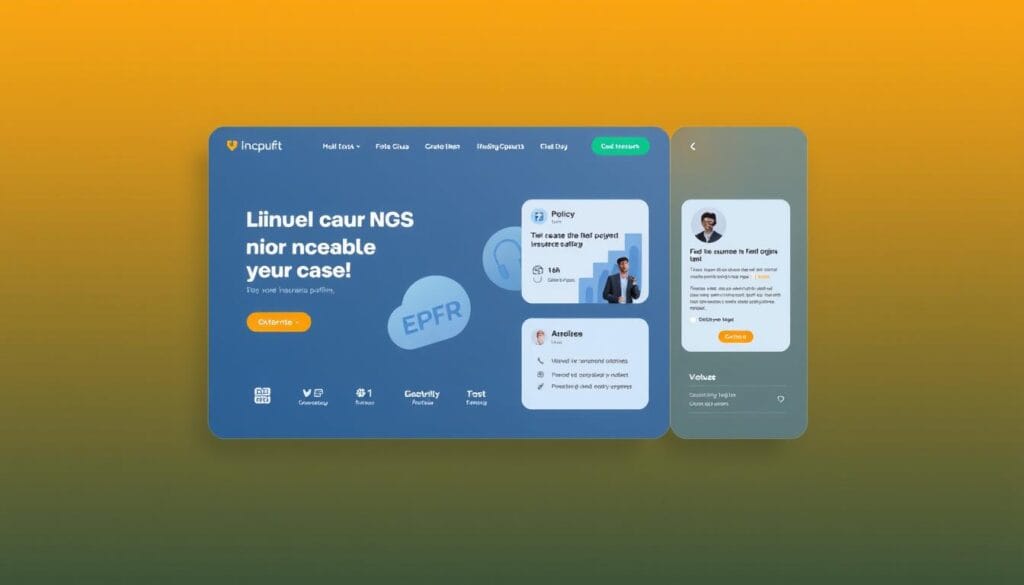The insurance industry is on the cusp of a significant transformation, with the digital insurance platform market expected to reach $229 billion by 2029. This surge is driven by 67% of insurance firms expediting their digital transformation efforts, signaling a shift away from legacy practices toward more streamlined, technology-powered processes.
The insurance software landscape is evolving rapidly, with technology playing a crucial role in shaping the industry’s future. As firms adopt innovative solutions for data management and market analysis, the overall industry is poised for substantial growth.
Key Takeaways
- The digital insurance platform market is projected to reach $229 billion by 2029.
- 67% of insurance firms have accelerated their digital transformation.
- Technology is driving significant changes in the insurance industry.
- Insurance software is becoming increasingly important for data management.
- The industry is shifting towards more streamlined, technology-driven processes.
The Digital Revolution in Insurance

The insurance industry is on the cusp of a digital revolution, driven by technological innovations and shifting consumer expectations. This transformation is not just about adopting new technology; it’s about fundamentally changing how insurance companies operate and interact with their customers.
Current State of Insurance Digitalization
The insurance industry is rapidly embracing digitalization, with a significant shift towards online platforms and digital solutions. According to recent data, a substantial percentage of insurers plan to integrate blockchain technology into their operations within the next two years, highlighting the industry’s commitment to digital transformation. This move is expected to enhance operational efficiency and reduce costs.
Market Growth Projections for 2025
The market for digital insurance platforms is poised for significant growth, with projections indicating a substantial increase by 2025. The global blockchain market in insurance is expected to reach $1.39 billion by the end of 2024, and insurers anticipate achieving $1.16 billion in cost savings from blockchain technology by 2025. This growth underscores the industry’s move towards more efficient and cost-effective solutions through the adoption of emerging technologies and platforms.
Benefits of Digital Insurance Platforms

By embracing digital insurance platforms, insurance companies can achieve substantial benefits, including enhanced customer experiences, improved operational efficiency, and reduced costs. These platforms transform traditional insurance operations into streamlined, customer-centric experiences, delivering tangible benefits to both insurance providers and their customers.
Enhanced Customer Experience
Digital insurance platforms enhance customer experiences through self-service portals and mobile applications, allowing policyholders to manage their policies and claims efficiently. Personalized interactions further improve satisfaction rates and customer retention. For instance, a study found that digital insurance platforms can shorten policy issuance times by as much as 30% in just six sessions.
Operational Efficiency Improvements
Automation, workflow optimization, and integrated systems reduce manual processes, minimize errors, and accelerate service delivery across the insurance value chain. This results in significant operational efficiency improvements, enabling insurance companies to provide faster and more reliable services. According to recent data, digital platforms have achieved a 90% turnaround time reduction for key insurance practices.
Cost Reduction Opportunities
Digital insurance platforms offer substantial cost reduction opportunities, including decreased administrative overhead, reduced fraud, and optimized resource allocation. For example, digital platforms have resulted in a 25% decrease in fraud for life insurance companies and a 65% reduction in costs overall. By leveraging these platforms, insurance companies can significantly improve their bottom line while enhancing customer satisfaction.
For more insights on the latest trends in insurance technology, visit our blog for in-depth analysis and expert opinions.
Key Features to Look for in Digital Insurance Platforms

When evaluating digital insurance platforms, organizations must prioritize key features that drive operational value and competitive advantage. Insurance software typically integrates various systems to provide a unified platform for managing insurance policies, tracking claims, and analyzing data.
Policy Management Capabilities
Advanced policy management capabilities are crucial for streamlining administrative processes and enhancing policy lifecycle management. These capabilities include policy issuance, renewals, endorsements, and cancellations, all of which can be efficiently managed through sophisticated insurance software.
Claims Processing Automation
Claims processing automation transforms claims handling from initial notification to settlement, reducing processing times and improving accuracy. By leveraging intelligent automation technologies, insurers can significantly enhance the customer experience. For more insights on streamlining insurance claims, visit Streamline Insurance Claims with AI in.
Data Analytics and Reporting
Sophisticated data analytics and reporting functionalities enable insurers to leverage their data assets for improved risk assessment, fraud detection, customer segmentation, and strategic decision-making. By utilizing real-time data and sophisticated algorithms, insurers can gain valuable insights that drive business growth.
Integration Capabilities
Integration capabilities are vital for seamless connectivity with existing systems, third-party services, and emerging technologies. Robust APIs and microservices architectures support enterprise-wide digital transformation initiatives, allowing insurers to stay competitive in a rapidly evolving market.
Best Digital Insurance Platforms 2025

In anticipation of 2025, we’ve evaluated the best digital insurance platforms that are poised to shape the industry’s future. Our comprehensive assessment focuses on identifying the top platforms that will lead the market in terms of technological innovation, customer satisfaction, and overall efficiency.
Selection Criteria
Our selection criteria for the best digital insurance platforms include technological innovation, market presence, customer satisfaction metrics, implementation success rates, and financial stability of the platform providers. We considered key features such as Policy Management, Claims Management, Customer Relationship Management (CRM), Data Analytics and Reporting, and Integration Capabilities.
Evaluation Methodology
Our evaluation methodology involved a systematic approach, incorporating expert interviews, customer reviews, technical specifications analysis, and performance benchmarking against industry standards. We weighted different evaluation factors to create a balanced assessment that considers both current capabilities and future potential, ensuring our recommendations remain relevant through 2025.
Vitaminise: Next-Gen CX Automation Platform

The insurance landscape is being transformed by Vitaminise’s next-generation CX automation and data platform. This innovative solution is designed to enhance customer experience and operational efficiency for insurance providers.
Key Features
Vitaminise offers a comprehensive suite of tools, including a mobile app, AI-powered chatbot, web portal, customer feedback mechanisms, and sophisticated data analytics capabilities. Key features include policy purchase, self-service symptom checker, doctor appointments, telemedicine, and lab test scheduling, all aimed at providing a seamless customer experience.
Pros
The platform’s strengths lie in its ability to deliver an omnichannel experience, robust self-service capabilities, and advanced automation features. Vitaminise has been shown to reduce operational costs while improving customer satisfaction metrics. For instance, insurers using Vitaminise have reported improved customer engagement and streamlined processes. You can explore more about digital insurance platforms on our comprehensive guide.
Cons
While Vitaminise offers numerous benefits, potential challenges include implementation complexities and integration with legacy systems. Additionally, considerations regarding customization options and pricing structure may impact the overall value proposition for some insurers.
Guidewire InsuranceSuite

Guidewire InsuranceSuite has established itself as a premier insurance platform, catering to the complex needs of modern insurers. It offers a robust suite of solutions designed to streamline core insurance operations.
Key Features
Guidewire InsuranceSuite boasts integrated policy administration, billing, and claims management modules. Its configurable product models and automated underwriting capabilities enhance operational efficiency. The platform’s comprehensive workflow management tools support insurers in adapting to changing market demands.
Pros
The platform’s scalability is proven for large insurance operations, and its extensive ecosystem of partners and integrations supports diverse business needs. Guidewire’s strong implementation methodology and continuous investment in innovation and cloud capabilities are significant advantages.
Cons
While Guidewire InsuranceSuite offers numerous benefits, considerations include implementation complexity, resource requirements, and total cost of ownership. The learning curve associated with maximizing the platform’s capabilities can also be a challenge for some insurers.
INSIS by Fadata

The INSIS insurance platform, developed by Fadata, is designed to support multiple lines of business across various geographic markets. As a core insurance system, INSIS allows insurance providers to effectively manage the majority of their crucial insurance processes.
Key Features
INSIS boasts a modular architecture, enabling flexible product configuration and comprehensive policy lifecycle management. Its claims processing functionality and business intelligence tools facilitate data-driven decision making, enhancing operational efficiency.
Pros
The INSIS platform offers multi-currency and multi-language support, making it an ideal solution for international insurance providers. Its extensive configurability without coding and robust workflow automation capabilities further contribute to its appeal, allowing insurers to streamline their operations.
Cons
While INSIS offers numerous benefits, its implementation complexity and potential integration challenges with legacy systems are considerations that insurance companies must take into account. Additionally, the platform’s market presence compared to larger competitors may be a factor in the decision-making process.
Majesco Insurance Platform

As insurance companies navigate digital transformation, the Majesco Insurance Platform emerges as a robust solution. This cloud-native insurance software is designed to cater to the diverse needs of property and casualty, life, and group insurance providers.
Key Features
The Majesco Insurance Platform boasts an array of features that make it an attractive choice for insurers. These include core insurance processing capabilities, digital engagement tools, and advanced analytics functions. The platform’s ecosystem of pre-integrated third-party services further enhances its functionality, allowing for streamlined operations and improved customer experiences.
Pros
The Majesco Insurance Platform offers several strengths, including its cloud-first architecture, which enables rapid deployment and scalability. Its extensive configurability allows insurers to tailor the platform to their specific needs, while its strong digital capabilities facilitate the launch of new products and enhanced customer engagement. For more insights on how Majesco addresses industry challenges, visit Yahoo Finance.
Cons
While the Majesco Insurance Platform offers numerous benefits, there are considerations to be made regarding its implementation complexity for certain use cases and its market presence compared to larger competitors. Insurers should weigh these factors when evaluating the platform’s suitability for their operations. For a broader understanding of insurance technology solutions, you may also refer to resources like AI Money Matters.
Implementing Digital Insurance Solutions
Implementing digital insurance solutions requires careful planning and execution to ensure a seamless transition. Insurance companies must consider several critical factors to successfully deploy digital insurance platforms.
Planning and Preparation Strategies
Effective planning and preparation are crucial for a successful software implementation. Insurance companies should set clear objectives, establish a comprehensive project plan, and allocate necessary resources. According to industry experts, “a well-planned implementation strategy is essential for insurance companies to reap the benefits of digital insurance solutions” Wolters Kluwer.
Data Migration Considerations
Data migration is a critical step in transitioning to new insurance software. It requires careful handling to ensure data integrity and accuracy. Insurance companies should consider data cleansing, mapping, validation, and testing methodologies to ensure a smooth transition.
Training and Onboarding Best Practices
Training and onboarding are crucial for ensuring that insurance company employees can effectively use the new business solutions. Companies should adopt role-based training approaches, change management strategies, and create internal champions to support the broader organization.
By following these best practices, insurance companies can successfully implement digital insurance solutions and improve their operations. A well-implemented digital insurance platform can help companies remain competitive in the market.
Future Trends in Digital Insurance
The digital insurance landscape is on the cusp of a revolution driven by emerging technologies. As insurers navigate this changing environment, understanding the trends that will shape the industry is crucial for strategic planning and technology investments.
AI and Machine Learning Integration
AI and machine learning are transforming core insurance processes, including underwriting, claims processing, fraud detection, and customer service. By leveraging these technologies, insurers can improve operational efficiency and enhance customer experience. For instance, AI-powered chatbots are being used to provide 24/7 customer support, while machine learning algorithms help in assessing risks more accurately.
Blockchain Applications in Insurance
Blockchain technology is enhancing transparency, security, and efficiency in insurance operations. Its applications in smart contracts, parametric insurance, reinsurance, and identity verification are particularly noteworthy. By 2025, the insurance industry is estimated to achieve $1.16 billion in cost savings from blockchain technology.
Hyper-Personalization of Insurance Products
The trend towards hyper-personalization is gaining momentum, with 45% of insurance providers expected to use it as a primary distinguishing factor by 2026. Advanced data analytics, IoT devices, and behavioral economics are enabling insurers to develop highly customized coverage options and pricing models tailored to individual risk profiles.
As the insurance industry continues to evolve, insurers must stay abreast of these trends to remain competitive. By embracing AI, blockchain, and hyper-personalization, insurers can improve their offerings and operational efficiency, ultimately driving growth and customer satisfaction.
Conclusion
As the insurance industry continues to evolve, digital platforms are becoming increasingly crucial for insurers to remain competitive.
The top digital insurance platforms of 2025 offer a range of benefits, including enhanced customer experience, operational efficiency improvements, and cost reduction opportunities.
Our analysis has highlighted the distinctive features and capabilities of leading platforms such as Vitaminise, Guidewire InsuranceSuite, INSIS by Fadata, and Majesco Insurance Platform.
These insurance software solutions deliver value to both insurance providers and their customers by addressing specific business needs and driving digital transformation.
To maximize return on investment, insurers should consider their current stage of digital transformation and select platforms that offer the necessary flexibility and scalability to adapt to future industry developments.
By doing so, insurers can mitigate risk and stay ahead in a rapidly changing industry, ultimately driving business success through innovative solutions.

